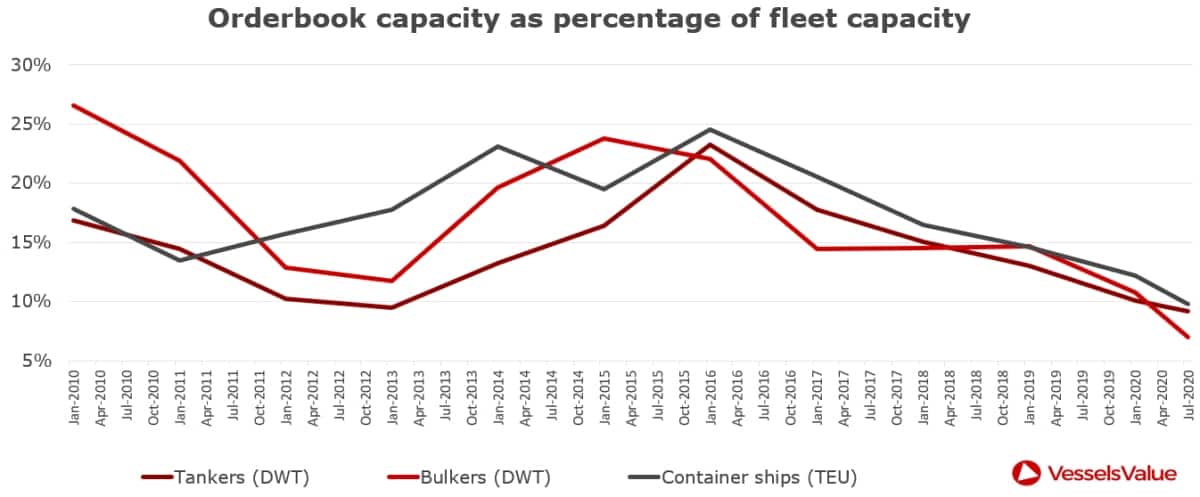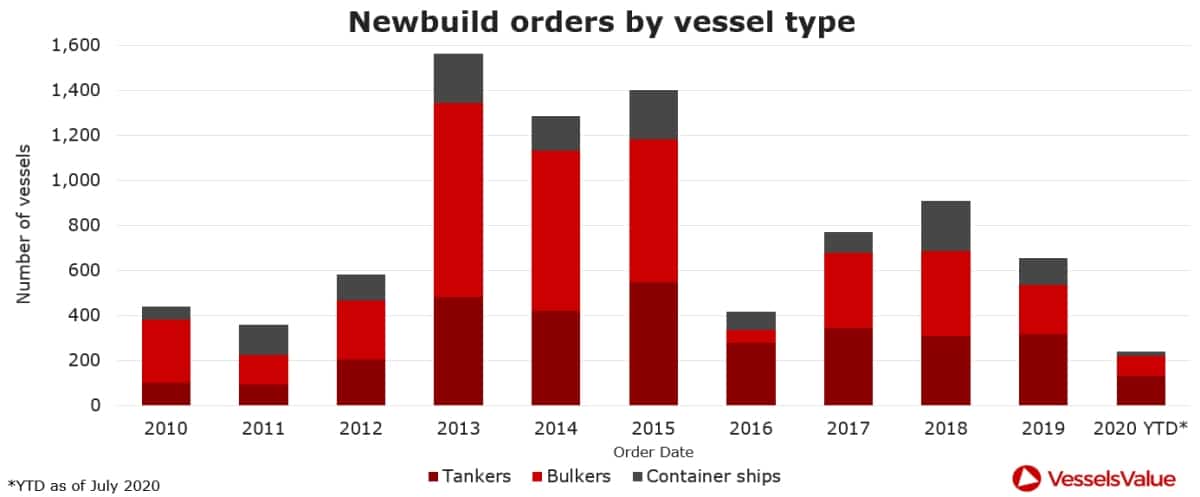Pre-COVID, the bull case for shipping rates was all about plunging newbuild orders. A drop in orders in 2019 pointed to rising freight rates in 2021, given the lag between contract signing and delivery.
Mid-COVID, the bull case for rates is even more about plunging newbuild orders than before. There will be a lot fewer vessels on the water in 2021, 2022 and beyond than previously thought.
New data provided to FreightWaves by U.K.-based VesselsValue confirms that 2020 is shaping up to be an exceptionally weak year for tanker, bulker and container-ship orders.
New data from Alphaliner shows that container-ship newbuild capacity is down to just 9.4% of capacity on the water. “For the first time in more than 20 years, the global newbuilding pipeline fell below the 10% threshold,” reported Alphaliner on Wednesday, calling it a “historic low.”
Tanker and bulker orderbooks
According to VesselsValue, the tanker orderbook has fallen to 9% of the operating fleet in terms of capacity (measured in deadweight tons or DWT) as of July. This is down sharply from a high of 23% in January 2016.
The dry bulk orderbook is only 7% of the on-the-water fleet. This is down from 24% in January 2015 and an even higher peak — 27% — in January 2010.

The number of ship orders year-to-date is extremely low.
VesselsValue data shows just 134 tanker orders through July, 28% below last year’s pace, despite historically high spot rates. Only 88 bulkers are on order, 31% below last year’s pace.

Clarksons Platou Securities has released data for specific tanker and bulker segments. For very large crude carriers (VLCCs, 200,000-plus DWT), the orderbook is only 7.4% of the on-the-water fleet. For Suezmaxes (120,000-199,999 DWT), it’s 11.3%.
In the products sector, the ratio is just 6.5% for medium-range (MR) tankers (30,000-59,999 DWT). It is 0.8% for long-range 1 (LR1) tankers (60,000-79,999 DWT) and 9.6% for LR2s (80,000-119,999 DWT).
In the dry bulk sector, Clarksons puts the orderbook-to-fleet ratio at 10% for Capesizes (120,000-plus DWT). It is 8% for Post-Panamaxes (85,000-119,999 DWT) and 6.8% for Panamaxes/Kamsarmaxes (65,000-84,999 DWT).
Container-ship orderbook
According to Alphaliner, the container-ship orderbook is down to just 2.21 million twenty-foot equivalent units (TEUs). This contrasts to a high of around 7 million TEUs in 2008. In that year, orderbook capacity was more than 60% of on-the-water capacity.
Of ships on order, virtually all are in the 10,000-plus TEU category or the 3,999-TEU-or-less category. There are effectively no orders in the midsized 4,000-9,999 TEU category.

Fear of premature obsolescence
Orderbooks are evaporating for two main reasons.
The first is regulation. The International Maritime Organization (IMO) has vowed to create rules to compel shipping to cut greenhouse gas (GHG) emissions by 50% by 2050, a regulatory target known as IMO 2050.
As Star Bulk (NASDAQ: SBLK) President Hamish Norton explained during a Marine Money virtual forum in June, “What may be legal today may not be legal in five years. In the old days, ships were grandfathered in until the end of their useful life. Given the political situation, people are afraid — I think with good reason — that a ship they order today will not be grandfathered in, and will become obsolete.”
Coronavirus effects
The second reason for the orderbook shortfall is COVID-19. Travel restrictions in the first half of the year made newbuild contracting extremely impractical. Furthermore, current and future economic fallout make it much tougher to pull the trigger on orders and get financing.
“If economic uncertainty can be measured by ship-ordering activity, then shipowners must be feeling completely lost at the moment,” wrote Stifel analyst Ben Nolan in a recent research note.
The pricing of secondhand ships is also undercutting the case for newbuilds. Newbuild prices are at too high a premium to secondhand prices for most orders to make sense.
Stamatis Tsantanis, CEO of Seanergy (NASDAQ: SHIP), explained during a Capital Link webinar last week that a secondhand 5-year-old Capesize costs around $30 million, whereas a newbuild costs $50 million. “The price differential is not justified by the incremental earnings [of the newbuild],” he pointed out.
Risks to rate upside
The IMO 2050-coronavirus one-two punch sounds like a guaranteed recipe for future freight-rate strength. But there are no guarantees in ocean shipping. Following is a devil’s advocate list of things that could go wrong:
Cargo demand could slump — A multiyear virus-induced recession or depression could cut cargo demand as much or more than vessel capacity. This would erase owners’ future rate-negotiation advantage.
Another demand risk relates to GHG emissions. If the world’s governments are serious about forcing GHG cuts by shipowners, wouldn’t they also force cuts of fossil-fuel consumption? And if so, wouldn’t this reduce future demand for tankers, bulkers and gas carriers?
Shipping regulations are not a sure thing — The IMO has no power to enforce regulations. Only IMO member nations do. GHG regulations for shipping can only move forward if they’re supported by countries with the most to gain from ocean trade, and by the world’s largest charterers.
The coronavirus changes the equation. One theory is that the cleaner post-lockdown skies and waters will drive momentum for environmentalism and GHG regulation. In this scenario, shipping decarbonization is more likely.
Another theory is that the outbreak will spur an extended period of economic pain and geopolitical unrest. In this scenario, countries would focus on rescuing economies and keeping transport costs cheap, making shipping decarbonization less likely.
If owners believe GHG regulations face significant delays, or may not happen at all, they could lose their fear of ordering.
Orders may go forward regardless of IMO 2050 and COVID headwinds — If rates jump in 2021-22 due to lower vessel supply, owners could decide to order regardless of the premature-obsolescence risk, on the belief that they’ll earn sufficient returns before obsolescence strikes. This would limit the duration of the upcycle.
Alternatively, if there is a deep economic slump due to the coronavirus and owners do not order ships, there could still be newbuilds — a lot of newbuilds.
Commercial shipbuilding is almost entirely based in China, South Korea and Japan. Asian governments could fill yard slots with orders by state-controlled shipowners tapping state-backed financing.
This would not only preserve Asian shipbuilding jobs, it would also depress freight rates — a plus for economies that benefit from cheap transport of raw-material imports and finished-goods exports. Economies like China’s.
Talk to a shipping veteran who has been around since the 1980s and the conversation will often turn to the infamous Sanko orders. In 1983, Japan’s Sanko Steamship Co. placed a $1.25 billion order at Japanese yards for 103 dry bulk newbuilds totaling 4 million DWT. The order helped Japanese yards but crippled rates for years.
The fear, if orders don’t pick up, is that an Asian shipbuilding nation will “pull a Sanko.” Most likely, China. Click for more FreightWaves/American Shipper articles by Greg Miller
MORE ON ENVIRONMENTALISM AND SHIPPING: Why shipping decarbonization hinges of owners of cargo, not ships: see story here. How decarbonization disincentivizes newbuilds: see story here. How decarbonization affects ship finance: see story here. Shipping’s blueprint for a future carbon tax: see story here.











